"Considerable Bungling Plus an Acute Shortage of Manpower"
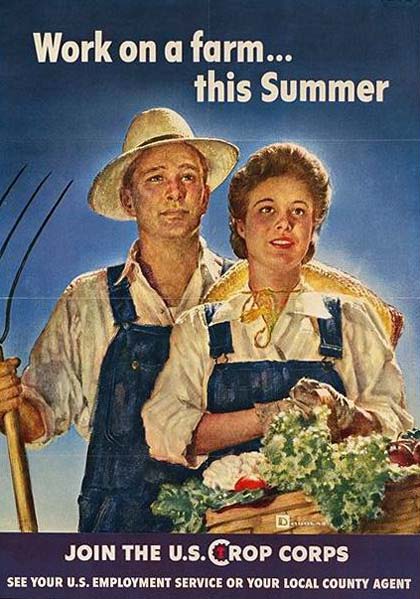 Posters showed a romantic view of farm work to entice town dwellers to help reduce the labor shortage.
U.S. Crop Corps image courtesy Northwestern University Library
Posters showed a romantic view of farm work to entice town dwellers to help reduce the labor shortage.
U.S. Crop Corps image courtesy Northwestern University Library World War II brought changes to farms across the country trying to cope with labor shortages and demands for higher production. Even though Congress authorized military deferments for farm workers in 1942, agricultural employment dropped by one million during the war. Among other things, this labor shortage spurred farmers to accelerate the use of mechanical equipment. It also contributed to the growing consolidation of small farms into larger, more commercial concerns, a trend that would continue after the war. But the most immediate result of the lack of farm workers was a raft of new federal farm labor programs that gave city and town dwellers the chance to bring in the crop for the war cause and get a taste of farm life in the process.
(
 Watch Dupont's 1943 "Farming During World War II: 'Soldiers of the Soil'"
Watch Dupont's 1943 "Farming During World War II: 'Soldiers of the Soil'" - via dailymotion.com)
Federal Agencies Dither
While farm labor shortages varied by region, the Pacific Northwest felt the results acutely. Some of the problem derived from the welter of federal agencies with authority over aspects of farm labor. For example, the Selective Service System, National War Labor Board, and War Manpower Commission all played a role in labor issues. By 1943 James Sheppard, director of the regional office of the federal Office of Civilian Defense, was frustrated after "pounding Washington with all the force I possess for some two months, insisting that there come out of Washington a unified approach to this problem...." He confided his concerns to a colleague in his Northwest Sector office: "You are undoubtedly much more familiar with the crisis in agricultural production which we are now facing, which in my opinion is a result of considerable bungling plus an acute shortage of manpower. The information at my disposal shows that in every state in our region, we are faced with the possibility that less acreage will be planted this year due to the inability of the farmer to be certain that he will be able to have the facilities with which to harvest such crops as he plants."
 Letter from James Landis and farming planFootnote
1
Letter from James Landis and farming planFootnote
1Oregon Farm Labor Shortages
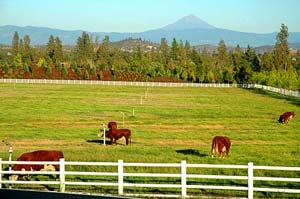 John Day, owner of the Blue Moon Ranch in the Medford area, pleaded with Gov. Sprague to find more farm workers. (Image no. jacD0016, Oregon Scenic Photos, OSA)
John Day, owner of the Blue Moon Ranch in the Medford area, pleaded with Gov. Sprague to find more farm workers. (Image no. jacD0016, Oregon Scenic Photos, OSA) Oregon farmers felt the crunch in the summer of 1942, leading Governor Sprague to call on citizens to "combine patriotism and profit by spending their Fourth of July holidays aiding the state's hard-pressed farmers." Sprague brought attention to the plight of western Oregon farmers: "I urge that every man, woman and child who can get away from usual occupations volunteer their services to help harvest cherries, strawberries, cane fruits and hay. More than ever in war time, we can not and must not let a pound of these valuable crops go to waste." Polk, Marion, and Clackamas counties were hardest hit. Along with calling on Oregonians to give up their holidays to work in fields and orchards, Sprague asked merchants and other city employers to "conduct their businesses with skeleton crews, releasing their employees for harvest work."
Footnote
2
Governor Sprague also received reports from embattled farmers and ranchers asking for help or advice. John Day, owner of the Blue Moon Ranch outside of Medford, told the governor in 1942 that he was contemplating curtailing his operations: "No man can properly handle 350 head of cattle and farm 500 acres, of which a good portion is garden, without skilled machine operators and experienced farm labor." Because of the labor shortage that summer, Day had sacrificed "several hundred tons of hay still stacked in the fields which should have been chopped into the barns as feed to fatten steers." He had only just returned with his wife, "along with one Army officer, one Naval officer, both on furlough, and two men from the ranch...[from] spending ten days riding in two feet of snow rounding up the cattle on a Government range. We were fortunate enough in finding most of them, but being late in the season there will be a few head which we cannot find and they will perish as the snow gets deep."
Day lamented that local high school students couldn't learn quickly how to operate the intricate farm machinery and asked Governor Sprague if he thought there would be adequate labor for the next season.
Footnote
3 Sprague replied that there were many reasons for pessimism, but he appealed to Day to not curtail his operation even though "it will mean a great strain for you and your wife.... You won't get any heroes medals but you should have the satisfaction of knowing that you carried on to the maximum of your ability in a time of need."
Footnote
4
There were many steps farmers and ranchers could take to reduce the impact of the labor shortage. The federal War Food Administration gave farmers 12 labor "short cuts" that included pooling machinery with neighboring farmers, getting portable fencing so it could be moved quickly, cutting unnecessary steps in farm chores, and using labor-saving devices. In fact, Medford rancher John Day took several steps to increase efficiency. Three years earlier he had foreseen a labor shortage and "began buying every labor saving machine that came within the proper bounds of economical operation." He also invented devices such as a tractor operated sugar beet weeder that took the place of 10 laborers and a sugar beet cutter and windrower, which combined to replace 35 laborers and drew attention from several farm machinery manufacturers who "sent their engineers to study and take pictures of this machinery, so possibly next year there may be some produced commercially." Day also imported a "group of good Mexican agricultural workers" from California's Sacramento Valley but he still fell short of the help needed to run his operation properly.
 Correspondence between John Day and Gov. SpragueFootnote
5
Correspondence between John Day and Gov. SpragueFootnote
5Finally, Meaningful Federal Action
By 1943 the federal government finally broke through its bureaucratic infighting to produce programs designed to help farmers such as John Day throughout the country. The creation of the U.S. Crop Corps and related programs helped stabilize the situation. The U.S. Crop Corps served as an umbrella for labor services such as the Women's Land Army and the Victory Farm Volunteers. If these sources failed to supply the necessary labor, farmers could ask for workers from other counties or from "surplus farm labor areas" that included Mexico. State agricultural extension services were given the job of coordinating the recruitment, training, and placement of laborers under the program. As part of this, the Oregon State College Extension Service established the Emergency Farm Labor Service, which operated from 1943 to 1947. The service helped place over 900,000 workers on farms throughout Oregon while managing 9 labor camps. The range of workers was broad, including urban women and youth, professionals, soldiers, returning war veterans, workers from other states, Mexican and Jamaican migrant workers, and German prisoners of war. Farmers in need of laborers contacted their county extension agent who coordinated the placement.
Footnote
6 Women's Land Army
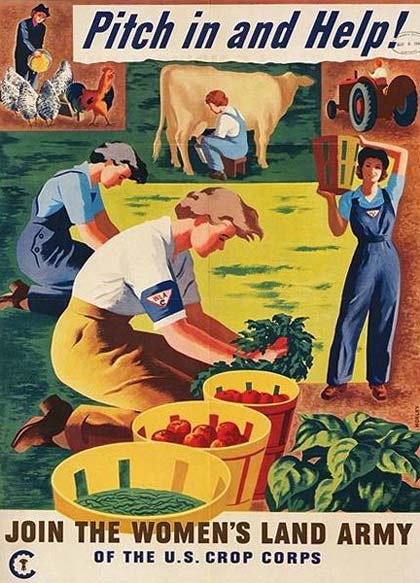 Women were urged to contribute on farms to help reduce the labor shortage. This poster shows several tasks typically handled by women.
Women's Land Army image courtesy Northwestern University Library
Women were urged to contribute on farms to help reduce the labor shortage. This poster shows several tasks typically handled by women.
Women's Land Army image courtesy Northwestern University Library The Women's Land Army, a separate unit of the U.S. Crop Corps, ramped up operations quickly in 1943. It employed women both year around and for shorter periods. Farmers employed most of the women on a "day-haul" basis in which the workers were given rides to the fields in school buses, farmers' trucks or personal cars. These women typically picked fruit, hoed, weeded or harvested vegetables, and helped with canning and processing food. Some did household work at the farm house, freeing up the often more experienced "womenfolk of the farm" to drive tractors and do other work that required more skill. Other women worked all year and received special training for dairy farm jobs and "other continuous farm activities." All members of the Women's Land Army had to be 18 years old and show a doctor's certificate verifying that they were in good health and "strong enough to do hard farm work." Nearly 135,000 placements of women were made from 1943 to 1947.
Footnote
7 Victory Farm Volunteers
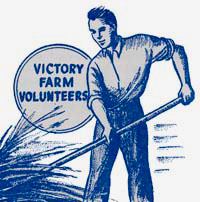 Over 270,000 youth placements were made in Oregon for the Victory Farm Volunteers. (Folder 13, Box 30, Defense Council, OSA)
Over 270,000 youth placements were made in Oregon for the Victory Farm Volunteers. (Folder 13, Box 30, Defense Council, OSA) The largest group of farm workers came from another unit of the U.S. Crop Corps called the Victory Farm Volunteers that employed youth from 11 to 17 years old. In Oregon youth committees composed of farmers and youth organization leaders formed in each county to anticipate labor needs and plan training to be given in local schools during the spring. Once out of school, the youths were organized into groups of from 20 to 50 individuals, after which they received more training. Farmers made specific labor requests to the emergency farm labor assistant in the county extension office. The youth platoons, often supervised by a member of the Women's Land Army, worked up to 6 hours a day on a day-haul basis.
Footnote
8
Parental consent and a physical examination were required to participate, but officials also looked for "those who are ready and willing to learn": "The recruitment of the youths is aimed at discouraging those who would be unable to adapt themselves to farm life and surroundings." Yet, at the same time they saw the program keeping at-risk youths out of trouble and having a "very direct and beneficial effect upon juvenile delinquency problems." Officials also had advice for farmers in their interactions with the young workers: "Whether you employ a member of the Victory Farm Volunteers or a member of the Boy Scouts or other patriotic organization that is urging its young members to work on farms this year, keep the youth's age in mind. Show him how to do things. Don't just tell him. He'll be anxious to do work that will harden his muscles. Don't let him do the heavy jobs all at once. A boy or girl of premilitary age is likely to want to overdo." Over the life of the program, more than 270,000 placements were made on farms and food processing facilities across Oregon.
Footnote
9Migrant Workers
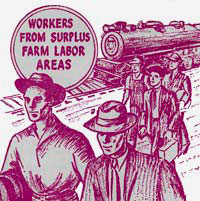 The Bracero Program brought over 15,000 Mexican workers to Oregon. (Folder 13, Box 30, Defense Council, OSA)
The Bracero Program brought over 15,000 Mexican workers to Oregon. (Folder 13, Box 30, Defense Council, OSA) Migrant workers from Mexico also eased Oregon's farm labor shortages. Their entry into the United States was made possible by a wartime farm labor agreement between the U.S. and Mexico that created the "Bracero Program." By 1943 these contract workers were garnering praise from Oregon farmers. Pea growers at Umatilla said the braceros saved their crop from loss. Hood River apple orchardists were happy to have new workers to fill "jobs requiring grown men rather than women and children." One farmer's wife summed it up: "We sure like these new Mexicans. They want to work all the time." But the braceros also experienced discrimination, wage disputes, poor housing and other problems. Some observers thought the labor force should be changed yearly. Otherwise, they argued, the men could become "too lonesome for home to the point of becoming unmanageable and insolent." One camp manager said that braceros who stayed longer "developed a propensity to get drunk and absent themselves from camp and work." Despite the mixed reviews about the migrant workers, few could argue that the program didn't help ease the farm labor shortage in the state. From 1942 to 1947 over 15,000 Mexican men worked on Oregon farms, ranches, and orchards as braceros.
Footnote
10 Other Contributors
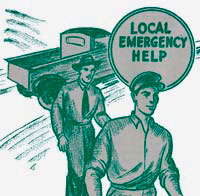 Townspeople could be mobilized quickly in many communities to bring in the crop if needed. (Folder 13, Box 30, Defense Council, OSA)
Townspeople could be mobilized quickly in many communities to bring in the crop if needed. (Folder 13, Box 30, Defense Council, OSA) The last years of the war saw the arrival of prisoners of war (POW) to work on farms. From 1944 to 1946 farmers could request help from POW laborers held at 6 camps operated by the Army in Oregon. Jackson, Benton, Polk and Marion counties each had one camp while Malheur County had two camps. More than 3,500 prisoners, mostly Germans, worked in Oregon fields. In 1945 they harvested 3.8 million pounds of hops in the Willamette Valley and in Malheur County they were largely responsible for the planting and harvesting of 7,500 acres of potatoes, 3,000 acres of lettuce, and 3,500 acres of onions.
Footnote
11
In many cases, whole towns would shut down to allow merchants, bankers, gas station attendants, and others "go to the fields to save crops."
Many other groups toiled long hours in Oregon farm fields during the war. The U.S. Crop Corps, with the help of civic organizations nationwide, organized a campaign to mobilize nonfarm workers to help during local farm emergencies. In many cases, whole towns would shut down to allow merchants, bankers, gas station attendants, and others "go to the fields to save crops." Some communities used defense council block leaders to canvass door-to-door to enlist volunteers. Sometimes local schools would close for a few days to bring in the potato crop or whatever needed to be harvested quickly while teachers worked much of the summer in the fields or canneries. The state put penitentiary inmates to work on farms in 1943. And, individual farms in Tillamook and Coos counties played host to conscientious objectors who served as farm laborers in lieu of military service. Many Oregonians, particularly those in the timber industry, moved from place to place following the harvest schedule before many returned to their old jobs. Meanwhile, over 1,000 placements of Japanese American workers were made in Malheur County between 1943 and 1945.
Footnote
12